市场营销 (双语) Chapter 6 Marketing Strategies
- 格式:ppt
- 大小:531.50 KB
- 文档页数:15

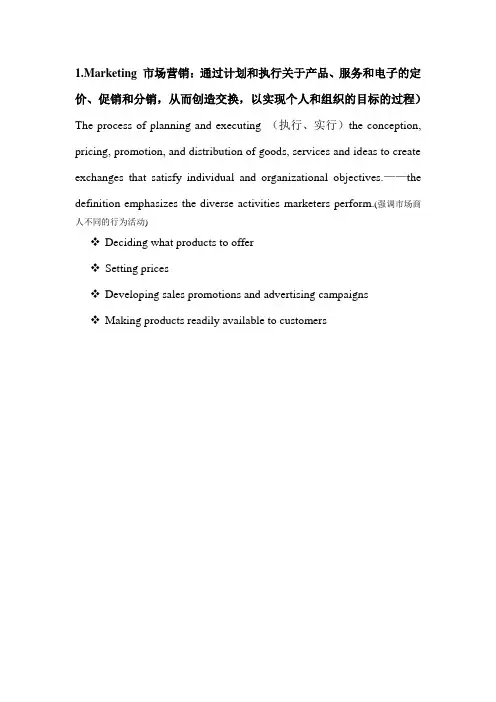
1.Marketing 市场营销:通过计划和执行关于产品、服务和电子的定价、促销和分销,从而创造交换,以实现个人和组织的目标的过程)The process of planning and executing (执行、实行)the conception, pricing, promotion, and distribution of goods, services and ideas to create exchanges that satisfy individual and organizational objectives.——the definition emphasizes the diverse activities marketers perform.(强调市场商人不同的行为活动)❖Deciding what products to offer❖Setting prices❖Developing sales promotions and advertising campaigns❖Making products readily available to customers2. The marketing Concepts(市场营销观念:企业分析消费者需求,制定比竞争对后更好的决策来满足这些需求的哲学)❖The Production Concept 生产观念❖The Selling Concept 推销观念❖The Marketing Concept 市场营销观念The Production Concept 生产观念The idea that a firm should focus on those products that it could produce most efficiently and that the low-cost products would create the demand for those products.The Selling Concept / sales concept 推销观念(利用广告这种重要方式来与其顾客沟通从而获取他们的订单) The Marketing Concept市场营销观念Difference between Selling and Marketing销售与营销的区别3.The Marketing Mix / The 4P’s of Marketing市场营销组合1)Product(产品:有形和无形,包括包装、色彩、品牌、服务,甚至销售商的声誉)Consumer products消费品:produced for and purchased byhouseholds for their use.Industrial products 工业产品:are sold primarily for use inproducing other products.2)Price(价格:消费者为获得产品所必须支付的金额)Refers to the value or worth of a product that attracts the buyer to exchange money or something of value for the product.Loss Leader Pricing(亏本出售商品)selling things in its lower price than its cost price in order to attract customers to purchase the products.Penetration Pricing (渗透定价法---心理定价策略)设定最初低价,以便迅速和深入地进入市场,从而快速吸引来大量的购买者,赢得较大的市场份赖。
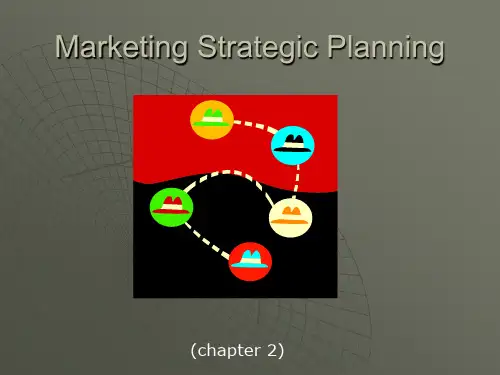
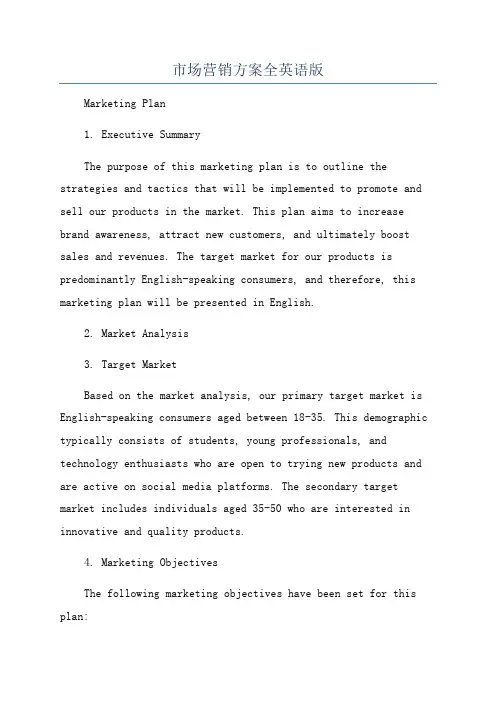
市场营销方案全英语版Marketing Plan1. Executive SummaryThe purpose of this marketing plan is to outline the strategies and tactics that will be implemented to promote and sell our products in the market. This plan aims to increase brand awareness, attract new customers, and ultimately boost sales and revenues. The target market for our products is predominantly English-speaking consumers, and therefore, this marketing plan will be presented in English.2. Market Analysis3. Target MarketBased on the market analysis, our primary target market is English-speaking consumers aged between 18-35. This demographic typically consists of students, young professionals, and technology enthusiasts who are open to trying new products and are active on social media platforms. The secondary target market includes individuals aged 35-50 who are interested in innovative and quality products.4. Marketing ObjectivesThe following marketing objectives have been set for this plan:- Increase brand awareness by 20% within the first six months.- Generate a 15% increase in sales within the first year.- Expand the customer base by 10% annually.- Obtain a customer satisfaction rating of 90% or above.5. Marketing Strategiesa. Social Media Marketing: Develop a strong presence on popular social media platforms such as Facebook, Instagram, and Twitter. Regularly post engaging content, share product updates, and interact with customers to build brand loyalty and attract new followers.b. Influencer Marketing: Collaborate with influential bloggers and social media personalities in the target market to promote our products through sponsored posts, reviews, and giveaways.c. Content Marketing: Create informative and entertaining blog articles, videos, and infographics that highlight the benefits and features of our products. Optimizing content for search engines will help attract organic traffic to our website.e. Public Relations: Develop relationships with journalists, bloggers, and industry influencers to secure media coverage and mentions. Press releases will be distributed to relevant media outlets to generate buzz about our products.6. Marketing Tacticsa. Product Launch Event: Organize a grand launch event for our new product, inviting media, influencers, and potential customers. This event will showcase the features, benefits, and unique selling points of the product.b. Giveaways and Contests: Conduct regular online giveaways and contests on social media platforms to engage customers and encourage them to share our brand with their networks. This tactic will help increase brand recognition and viral reach.d. Customer Referral Program: Implement a customer referral program that rewards customers who refer their friends andfamily to purchase our products. Rewards may include discounts, free products, or exclusive offers.e. Online Advertising: Run targeted online advertising campaigns on platforms such as Google AdWords and social media sites. This will help increase brand visibility, drive website traffic, and reach potential customers who are actively searching for similar products.7. Financial ProjectionsDetailed financial projections will be created to estimate the costs associated with implementing the marketing strategies and tactics outlined in this plan. This will include budgets for social media advertising, influencer collaborations, contentcreation, events, and other marketing initiatives. Revenue forecasts will be based on historical data, market trends, and anticipated customer acquisition rates.8. Monitoring and EvaluationRegular monitoring and evaluation of the marketingstrategies will be conducted to determine their effectiveness. Key performance indicators such as website traffic, social media engagement, sales conversions, customer feedback, and return on investment will be tracked and analyzed. Based on the results, adjustments and improvements to the marketing plan will be made as necessary.Conclusion。
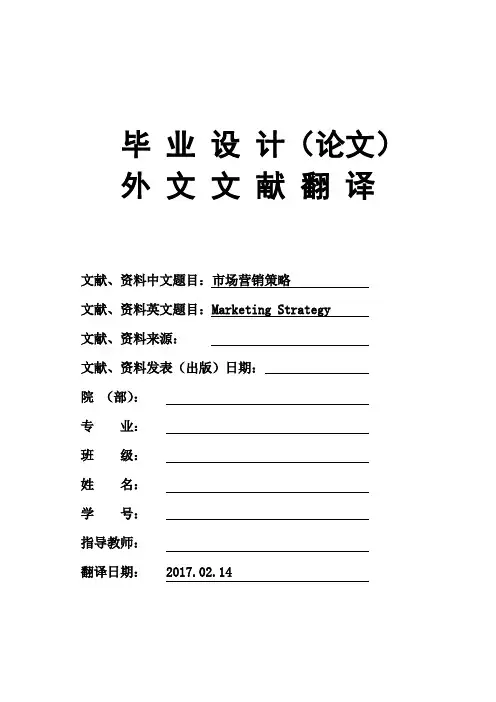
毕业设计(论文)外文文献翻译文献、资料中文题目:市场营销策略文献、资料英文题目:Marketing Strategy文献、资料来源:文献、资料发表(出版)日期:院(部):专业:班级:姓名:学号:指导教师:翻译日期: 2017.02.14市场营销策略1 市场细分和目标市场策略具有需求,具有购买能力并愿意花销的个体或组织构成了市场。
然而,在大多数市场中,购买者的需求不一致。
因此,对整个市场采用单一的营销计划可能不会成功。
一个合理的营销计划应以区分市场中存在的差异为起点,这一过程被称为市场细分,它还包括将何种细分市场作为目标市场。
市场细分使公司能更加有效地利用其营销资源。
而且,也使得小公司可以通过集中在一两个细分上场上有效地参与竞争。
市场细分的明显缺点是,其导致了比单一产品、单一大市场策略更高的生产和营销成本。
但是,如果市场细分得当的话,更加符合消费者的需求,实际上将生产更高的效率。
确定目标市场有三种可供选择的策略,它们是统一市场、单一细分市场和多重细分市场。
统一市场策略即采取一种营销组合用到一个整体的、无差异的市场中去。
采取单一细分市场策略,公司仍然仅有一种营销组合,但它只用在整个市场的一个细分市场中。
多重细分市场策略需要选择两个或更多的细分市场,并且每个细分市场分别采用一种单独的营销组合。
2 产品定位管理者将注意力集中于一种品牌,并以恰当的方式将其与类似的品牌相区分,但这并不意味着该品牌就一定能够最后赢利。
因此,管理者需要进行定位,即塑造与竞争品牌和竞争对手的其他品牌相关的自我品牌形象。
市场营销人员可以从各种定位策略中加以选择。
有时,他们决定对某一特定产品采用一种以上的策略。
以下是几种主要的定位策略:2.1与竞争者相关的定位对一些产品来说,最佳的定位是直接针对竞争对手。
该策略特别适用于已经具有固定的差别优势或试图强化这种优势的厂商。
为排挤微处理器的竞争对手,Intel公司开展了一项活动使用户确信它的产品优于竞争对手的产品。
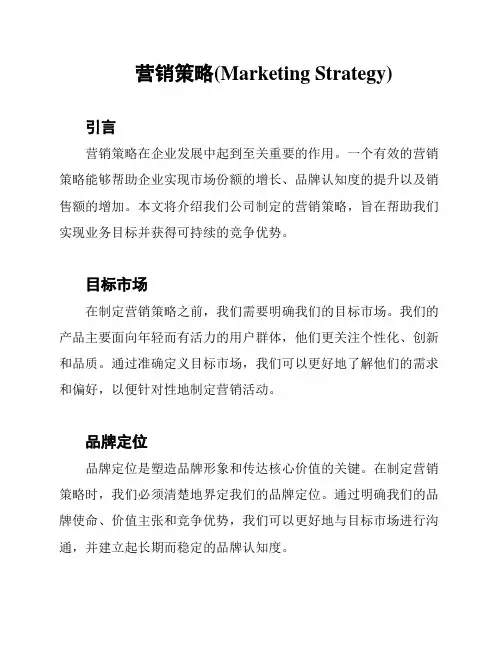
营销策略(Marketing Strategy)引言营销策略在企业发展中起到至关重要的作用。
一个有效的营销策略能够帮助企业实现市场份额的增长、品牌认知度的提升以及销售额的增加。
本文将介绍我们公司制定的营销策略,旨在帮助我们实现业务目标并获得可持续的竞争优势。
目标市场在制定营销策略之前,我们需要明确我们的目标市场。
我们的产品主要面向年轻而有活力的用户群体,他们更关注个性化、创新和品质。
通过准确定义目标市场,我们可以更好地了解他们的需求和偏好,以便针对性地制定营销活动。
品牌定位品牌定位是塑造品牌形象和传达核心价值的关键。
在制定营销策略时,我们必须清楚地界定我们的品牌定位。
通过明确我们的品牌使命、价值主张和竞争优势,我们可以更好地与目标市场进行沟通,并建立起长期而稳定的品牌认知度。
渠道选择渠道选择是将产品和目标客户联系起来的重要环节。
我们将通过多种渠道来传播我们的产品和品牌,包括线上和线下渠道。
线上渠道包括社交媒体、电子商务平台和网站推广等,而线下渠道则包括实体店铺、展会和合作伙伴等。
通过合理选择渠道并综合运用它们,我们能够更好地覆盖目标市场,并与潜在客户进行有效的互动和沟通。
产品定价在制定产品定价策略时,我们需要综合考虑多个因素,包括市场需求、竞争对手定价和成本等。
我们将采取差异化定价策略,根据产品的独特性和价值为不同的客户群体设定相应的价格。
同时,我们也将提供一些促销活动和优惠,以吸引客户并增加销售额。
市场推广市场推广是营销策略中不可或缺的一环。
我们将采取多种市场推广手段,包括广告、公关、内容营销和口碑营销等。
通过精确定位受众群体、创造有吸引力的广告内容以及积极借助社交媒体和公众平台进行宣传,我们将提高品牌知名度并吸引更多的目标客户。
销售与服务销售与服务是营销策略的最终目的。
我们将建立高效的销售团队,专注于了解客户需求、提供个性化的解决方案以及建立良好的客户关系。
同时,我们也将持续提供优质的售后服务,以增加客户的忠诚度并促进重复购买。
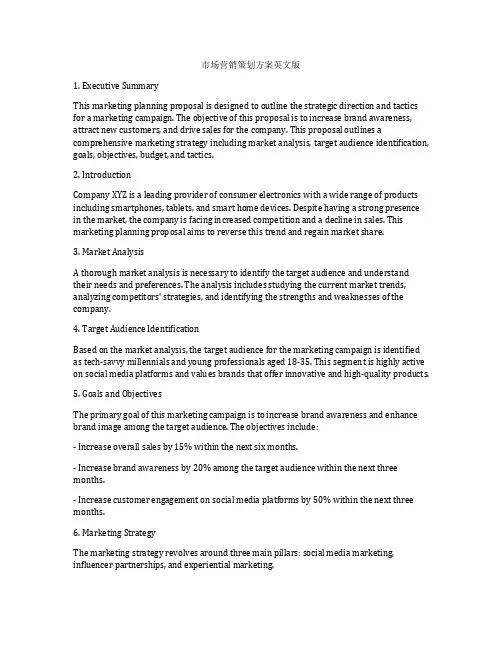
市场营销策划方案英文版1. Executive SummaryThis marketing planning proposal is designed to outline the strategic direction and tactics for a marketing campaign. The objective of this proposal is to increase brand awareness, attract new customers, and drive sales for the company. This proposal outlines a comprehensive marketing strategy including market analysis, target audience identification, goals, objectives, budget, and tactics.2. IntroductionCompany XYZ is a leading provider of consumer electronics with a wide range of products including smartphones, tablets, and smart home devices. Despite having a strong presence in the market, the company is facing increased competition and a decline in sales. This marketing planning proposal aims to reverse this trend and regain market share.3. Market AnalysisA thorough market analysis is necessary to identify the target audience and understand their needs and preferences. The analysis includes studying the current market trends, analyzing competitors' strategies, and identifying the strengths and weaknesses of the company.4. Target Audience IdentificationBased on the market analysis, the target audience for the marketing campaign is identified as tech-savvy millennials and young professionals aged 18-35. This segment is highly active on social media platforms and values brands that offer innovative and high-quality products.5. Goals and ObjectivesThe primary goal of this marketing campaign is to increase brand awareness and enhance brand image among the target audience. The objectives include:- Increase overall sales by 15% within the next six months.- Increase brand awareness by 20% among the target audience within the next three months.- Increase customer engagement on social media platforms by 50% within the next three months.6. Marketing StrategyThe marketing strategy revolves around three main pillars: social media marketing, influencer partnerships, and experiential marketing.6.1 Social Media MarketingA comprehensive social media marketing plan will be executed to reach and engage with the target audience. This includes creating and optimizing social media profiles, developing a content calendar with relevant and engaging posts, and running targeted advertising campaigns.6.2 Influencer PartnershipsPartnering with influencers is an effective way to reach the target audience and gain credibility. Key opinion leaders in the consumer electronics industry will be identified and engaged to promote the company's products through sponsored content and product reviews.6.3 Experiential MarketingCreating immersive experiences for potential customers is crucial in showcasing the products' features and benefits. This can be achieved through pop-up stores, product launch events, and interactive demonstrations in high-traffic areas.7. Budget AllocationA detailed budget allocation plan is essential to ensure efficient spending of marketing resources. The budget will be divided as follows:- Social media marketing: 40%- Influencer partnerships: 25%- Experiential marketing: 20%- Miscellaneous expenses: 15%8. Measurement and EvaluationTo monitor the effectiveness of the marketing campaign, key performance indicators (KPIs) will be established. These include but are not limited to sales growth, website traffic, social media engagement, and customer feedback. Regular monitoring and analysis of these KPIs will guide future marketing decisions and help evaluate the campaign's success.9. ConclusionThis marketing planning proposal provides a comprehensive strategy for XYZ Company to improve brand awareness, attract new customers, and drive sales. By leveraging social media marketing, influencer partnerships, and experiential marketing, the company can successfully engage with the target audience and achieve its goals and objectives. With proper monitoring and evaluation, adjustments can be made to optimize the campaign and ensure long-term success.。
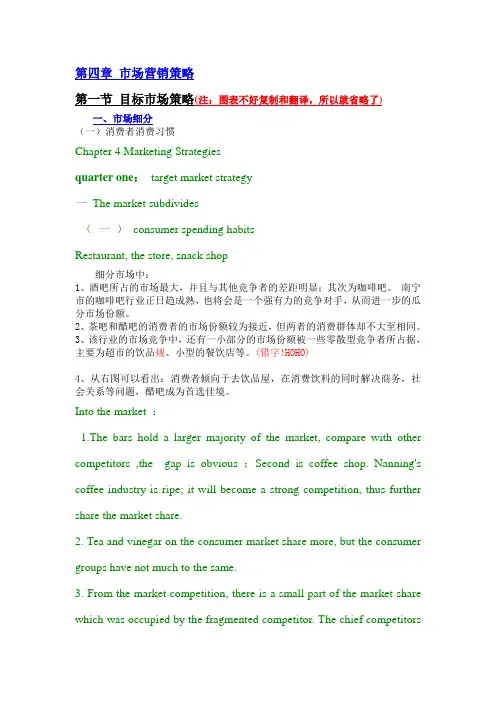
第四章市场营销策略第一节目标市场策略(注:图表不好复制和翻译,所以就省略了)一、市场细分(一)消费者消费习惯Chapter 4 Marketing Strategiesquarter one:target market strategy一The market subdivides(一)consumer spending habitsRestaurant, the store, snack shop细分市场中:1、酒吧所占的市场最大,并且与其他竞争者的差距明显;其次为咖啡吧。
南宁市的咖啡吧行业正日趋成熟,也将会是一个强有力的竞争对手,从而进一步的瓜分市场份额。
2、茶吧和醋吧的消费者的市场份额较为接近,但两者的消费群体却不大至相同。
3、该行业的市场竞争中,还有一小部分的市场份额被一些零散型竞争者所占据,主要为超市的饮品规、小型的餐饮店等。
(错字!HOHO)4、从右图可以看出:消费者倾向于去饮品屋,在消费饮料的同时解决商务,社会关系等问题,醋吧成为首选佳境。
Into the market :1.The bars hold a larger majority of the market, compare with othercompetitors ,the gap is obvious ;Second is coffee shop. Nanning'scoffee industry is ripe; it will become a strong competition, thus furthershare the market share.2. Tea and vinegar on the consumer market share more, but the consumergroups have not much to the same.3. From the market competition, there is a small part of the market sharewhich was occupied by the fragmented competitor. The chief competitorsare drink of market or small restaurants, etc.4. And from the right picture can be seen that :consumers tend to go to drink in the house, and do business or deal with social relationship during the drinking time, so vinegar bar is the best choice.(二)消费者偏好(二)consumer preference由以上可以看出:喜欢和偏酸和酸甜结合口味饮料的人占到了41%和49%,这正好于醋饮具有的口味相吻合,有利于醋饮被广大写消费者接受。
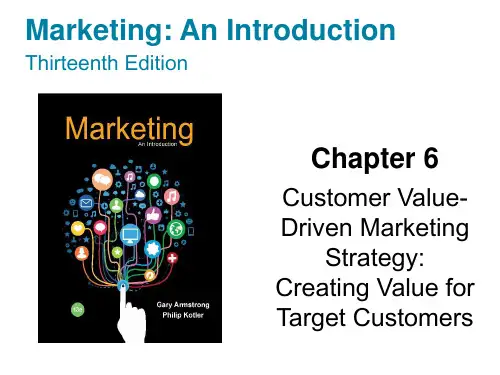
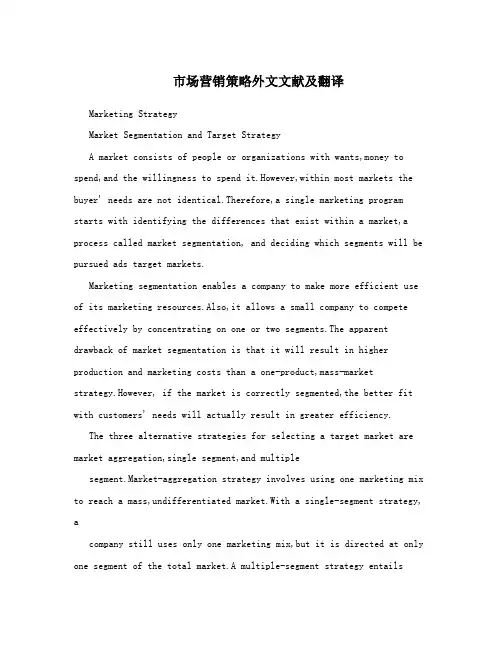
市场营销策略外文文献及翻译Marketing StrategyMarket Segmentation and Target StrategyA market consists of people or organizations with wants,money to spend,and the willingness to spend it.However,within most markets the buyer' needs are not identical.Therefore,a single marketing program starts with identifying the differences that exist within a market,a process called market segmentation, and deciding which segments will be pursued ads target markets.Marketing segmentation enables a company to make more efficient use of its marketing resources.Also,it allows a small company to compete effectively by concentrating on one or two segments.The apparent drawback of market segmentation is that it will result in higher production and marketing costs than a one-product,mass-marketstrategy.However, if the market is correctly segmented,the better fit with customers' needs will actually result in greater efficiency.The three alternative strategies for selecting a target market are market aggregation,single segment,and multiplesegment.Market-aggregation strategy involves using one marketing mix to reach a mass,undifferentiated market.With a single-segment strategy, acompany still uses only one marketing mix,but it is directed at only one segment of the total market.A multiple-segment strategy entailsselecting two or more segments and developing a separate marketing mix to reach segment.Positioning the ProductManagement's ability to bring attention to a product and to differentiate it in a favorable way from similar products goes a long way toward determining that product's revenues.Thus management needs to engage in positioning,which means developing the image that a product projects in relation to competitive products and to the firm's other products.Marketing executives can choose from a variety of positioning strategies.Sometimes they decide to use more than one for a particular product.Here are several major positioning strategies:1.Positioning in Relation to a competitorFor some products,the best position is directly against the competition.This strategy is especially suitable for a firm that already has a solid differential advantage or is trying to solidify such an advantage.To fend off rival markers of microprocessors,Intelunched a campaign to convince buyers that its product is superior to competitors.The company even paid computer makers to include the slogan,"Intel Inside" in their ads.As the market leader,Coca-Cola introduces new products and executes its marketing strategies.At the same time,it keeps an eye on Pepsi-Cola,being sure to match anyclever,effective marketing moves made by its primary competitor.2.Positioning in Relation to a Product Class or AttributeSometimes a company's positioning strategy entails associating its product with or distancing it from a product class or attributes.Some companies try to place their products in a desirable class,such as"Madein the USA."In the words of one consultant,"There is a strong emotional appeal when you say,'Made in the USA'".Thus a small sportswear manufacturer,Boston Preparatory Co.is using this positioning strategy to seek an edge over large competitors such as Calvin Klein and Tommy Hilfiger,which don't produce all of their products in the U.S..3.Positioning by Price and QualityCertain producer and retailers are known for their high-quality products and high prices.In the retailing field,Sake Fifth Avenue and Neiman Marcus are positioned at one end of the price-qualitycontinuum.Discount stores such as Target and Kmart are at theother.We're not saying,however,that discounters ignore quality;rather, they stress low prices.Penney's tired―and for the most part succeeded in―repositioning its stores on the price-quality continuum by upgrading apparel lines and stressing designer names.The word brands is comprehensive;it encompasses other narrowerterms.A brand is a name and/or mark intended to identify the product of one seller or group of sellers and differentiate the product from competing products.A brand name consists of words,letters,and/or numbers that can be vocalized.A brand mark is the part of the brand that appears in the form of a symbol, design,or distinctive color or lettering.A brand mark isrecognized buy sight bu cannot be expressed when a person pronounces the brand name.Crest,Coors,and rider for Ralph Lauren's Polo Brand.Green Giant canned and frozen vegetable products and Arm&Hammer baking soda are both brand names and brand marks.A trademark is a brand that has been adopted by a seller and given legal protection.A trademark includes not just the brand mark,as many people believe,but also the brand name.The Lanham Act of 1946 permits firms to register trademarks with the federal government to protect them from use or misuse by other companies.The Trademark Law RevisionAct,which took effect in 1989,is tended to strengthen the the registration system to the benefit of U.S. Firms.For sellers,brands can be promoted.They are easily recognized when displayed in a store or included in advertising.Branding reduces price comparisons.Because brands are another factor that needs to be considered in comparing different products,branding reduces the likelihood of purchase decision based solely on price.The reputation of a brand alsoinfluences customer loyalty among buyers of services as well as customer goods.Finally,branding can differentiate commodities Sunkist oranges,Morton salt,and Domino sugar,for example .PricingPricing is a dynamic process,Companies design a pricing structure that covers all their products.They change this structure over time and adjust it to account for different customers and situations.Pricing strategies usually change as a product passes through itslife cycle.Marketers face important choice when they select new product pricing strategies.The company can decide on one of several price-quality strategies for introducing an imitative product.In pricing innovative products,it can practice market-skimming pricing by initially setting high prices to"skim"the imum amount of revenue from various segments of the market.Or it can use market penetration pricing by setting a low initial price to win a large market share.Companies apply a variety of price-adjustment strategies to account for differences in consumer segments and situations.One is discount and allowance pricing,whereby the company decides on quantity,functional,or seasonal discounts,or varying types of allowances. A second strategy is segmented pricing, where the company sellers a product at two or more prices to allow for differences in customers, products, or locations. Sometimes companies consider more than economics in their pricing decisions,and use psychological pricing to communicate about the product's quality or value.In promotional pricing,companies temporarily sell their product bellow list price as a special-event to draw more customers,sometimes even selling below cost.With value pricing, the company offers just the night combination of quality and good service at a fair price. Another approach is geographical pricing, whereby the company decides how to price distant customers, choosing fromalternative as FOB pricing,uniform delivered pricing, zone pricing, basing-point pricing, and freight-absorption pricing. Finally,international pricing means that the company adjusts its price to meet different world markets.Distribution ChannelsMost producers use intermediaries to bring their products to market.They try to forge a distribution channel―a set of interdependent organizations involved in the process of marking a product or service available for use or consumption by the consumers or business user.Why do producers give some of the selling job tointermediaries?After all,doing so means giving up some control over how and to whom the products are sold.The use of intermediaries results from their greater efficiency in marking goods available to targetmarkets.Through their contacts, experience, specialization, and scales of operation,intermediaries usually offer the firm move value than it can achieve on its own efforts.A distribution channel moves goods from producers to customers.Itovercomes the major time, place, and possession gaps that separate goods and services from those who would use them. Members of the marketing channel perform many functions. Some help to complete transactions:rmation.2.Promotion.3.Contact:finding and communicating with prospective buyers.4.Matching:fitting the offer to the buyer's needs, including such activities as manufacturing and packaging.5.Negotiation:reaching an agreement on price and other terms of the offer so that ownership or possession can be transferred.Other help to fulfill the completed transferred.1.Transporting and storing goods.2.Financing.3.Risk taking:assuming the risk of carrying out the channel work.The question is not whether these functions need to be performed, but rather who is to perform them. All the functions have three things in common:They use up scarce resource, they often can be performed better through specialization, and they can be shifted among channel members.To the extent that the manufacturer performs these functions, its costs go up and its prices have to be higher. At the same time, when some of these functions are shifted to intermediaries, the producer's costs and prices may be lower, but the intermediaries must charge more to cover the costsof their work. In dividing the work of the channel, the various functions should be assigned to the channel members who can perform them most efficiently and effectively to provide satisfactory assortments of goods to target consumers.Distribution channels can be described by the number of channellevels involved. Each layer of marketing intermediaries that performs some work in brining the product and its ownership closer to the final buyer is a channel level. Because the producer and the final consumer both perform some work, they are part of every channel.When selecting intermediaries, the company should determine what characteristics distinguish the better ones. It will want to evaluate the the channel member's years in business, other lines carried, growth and profit record, co-operativeness, and reputation. If the intermediaries are sales agents, the company will want to evaluate the number and character of the other lines carried, and the size andquality of the sales force. If the intermediary is a retail store that wants exclusive or selective distribution, the company will want to evaluate the store's customers, location, and future growth potential.Understanding the nature of distribution channels is important, as choosing among distribution channels is one of the most challenging decisions facing the firm. Marketing intermediaries are used because they provide greater efficiency in marking goods available to target markets.The key distribution channel function is moving goods from producers to consumers by helping to complete transactions and fulfill the completed transaction. Distribution channels can be described by the number of channel levels, which can include no intermediaries in adirect channel, or one to several intermediaries in indirect channels.PromotionPromotion is one of the four major elements of the company's marketing mix. The main promotion tools――advertising, sales promotion, public relations, and personal selling――work together to achieve the company'scommunications objectives.People at all levels of the organization must be aware of the many legal and ethical issues surrounding marketing communications. Much work is required to produce socially responsible marketing communicating in advertising, personal selling, and direct selling. Companies must work hard and proactively at communicating openly, honestly, and agreeably with their customers and resellers.市场营销策略一、市场细分和目标市场策略具有需求,具有购买能力并愿意花销的个体或组织构成了市场。
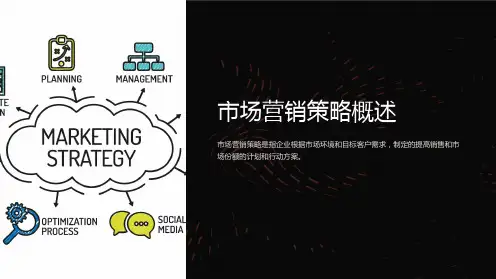
【商务英语】市场营销(中英)1.Marketing 市场营销:通过计划和执行关于产品、服务和电子的定价、促销和分销,从而创造交换,以实现个人和组织的目标的过程)The process of planning and executing (执行、实行)the conception, pricing, promotion, and distribution of goods, services and ideas to create exchanges that satisfy individual and organizational objectives.——the definition emphasizes the diverse activities marketers perform.(强调市场商人不同的行为活动) Deciding what products to offerSetting pricesDeveloping sales promotions and advertising campaignsMaking products readily available to customers2. The marketing Concepts(市场营销观念:企业分析消费者需求,制定比竞争对后更好的决策来满足这些需求的哲学)The Production Concept 生产观念The Selling Concept 推销观念The Marketing Concept 市场营销观念The Production Concept 生产观念The idea that a firm should focus on those products that it could produce most efficiently and that the low-cost products would create the demand for those products.The Selling Concept / sales concept 推销观念(利用广告这种重要方式来与其顾客沟通从而获取他们的订单)The Marketing Concept市场营销观念Difference between Selling and Marketing销售与营销的区别Selling:先销售再…Marketing:先调查市场需要再…Emphasis is on the product.Emphasis is on customers’ wants.Company first makes the product and then figures out how to sell it.Company first determines customers’ wants and then figures out how to make and deliver a product to satisfy those wants.Management is sales-volume-oriented.Management is profit-oriented.Planning is short-run, in terms of today’s products and markets.Planning is long term, in the sense of new products, tomorrow’s market, and future growth. Stresses needs of seller.Stresses wants of buyers.3.The Marketing Mix / The 4P’s of Marketing市场营销组合1)Product(产品:有形和无形,包括包装、色彩、品牌、服务,甚至销售商的声誉)Consumer products消费品:produced for and purchased by households for their use. Industrial products 工业产品:are sold primarily for use in producing other products.2)Price(价格:消费者为获得产品所必须支付的金额)Refers to the value or worth of a product that attracts the buyer to exchange money or something of value for the product.Loss Leader Pricing (亏本出售商品)selling things in its lower price than its cost price in order to attract customers to purchase the products.Penetration Pricing (渗透定价法---心理定价策略)设定最初低价,以便迅速和深入地进入市场,从而快速吸引来大量的购买者,赢得较大的市场份赖。
Marketing市场营销(英文版)Marketing is a critical aspect of any business. It involves promoting and selling products or services to customers through various strategies and channels. In today's competitive market, effective marketing techniques are essential to differentiate a company from its competitors and maximize its potential for success.One of the primary goals of marketing is to understand customer needs and wants. By conducting market research and gathering data, companies can identify their target audience and tailor their marketing efforts accordingly. This customer-centric approach allows businesses to create products or services that meet customer demands and exceed their expectations.Marketing involves developing an effective marketing mix, which includes the product, price, promotion, and place. The product refers to the goods or services being offered and must meet customer needs and preferences. Setting the right price is crucial to ensure the product's affordability and value. Promotion involves the various strategies used to communicate with potential customers and create awareness about the product or service. Lastly, ensuring the product is available at the right place and time is essential to enable customers to access and purchase it conveniently.Digital marketing has become an integral part of successful marketing campaigns. With the widespread use of the internet and social media, companies need to embrace online marketing techniques to reach a broader audience. Digital marketingstrategies include search engine optimization (SEO), content marketing, social media advertising, email marketing, and influencer marketing. These methods help businesses connect with potential customers, increase brand visibility, and generate leads.Another critical aspect of marketing is building and maintaining strong customer relationships. Customer relationship management (CRM) is a strategy that helps companies track and analyze customer interactions to improve their overall experience. By understanding customer preferences, addressing their concerns, and providing excellent customer service, companies can build loyalty and retain customers in the long run.In today's fast-paced and highly competitive market, companies need to stay ahead of their competitors by continuously enhancing their marketing strategies. This requires staying updated with the latest marketing trends and technologies, monitoring competitor activities, and adapting accordingly. Additionally, companies must be flexible and willing to adjust their marketing efforts as market conditions and customer preferences change.In conclusion, marketing plays a vital role in the success of any business. By understanding customer needs, developing an effective marketing mix, embracing digital marketing techniques, and building strong customer relationships, companies can maximize their potential and stay ahead of the competition. It is crucial for businesses to continuously improve their marketing strategies to remain relevant and meet the evolving demands of their target audience.继续发展相关主题-内容营销:内容营销是当下营销领域的一个重要策略。
一、市场营销学双语资料1、企业跨国营销进展五个时期?the five stages of International MarketingDevelopment?国内营销〔domestic marketing〕、出口营销〔exporting marketing〕、国际营销〔international marketing〕、多国营销〔multinational markrting〕、全球营销〔global marketing〕2、企业哪几种形式进入外国市场?What kinds of forms to enter foreignmarkets?出口进入模式、投资进入模式、契约进入模式、互联网进入模式3、经营哲学演变五个时期?the five stages of the evolution of managementphilosophy?以生产为导向的传统营销观念〔traditional marketing concept〕以国外顾客为导向的营销新观念〔new marketing concept〕以外部环境为导向的营销战略观念〔stategic marketing concept〕以全球市场为导向的全球营销观念〔global marketing concept〕4、中间商按是否拥有所有权可分为哪两种?whether by ownership ofintermediaries which can be divided into two?经销中间商、代理中间商5、产品整体观念五个层次?the five levels of product?核心产品〔core product〕、一样产品〔actual product〕、期望产品〔expected product〕、附加产品〔augmented product〕、潜在产品〔potential product〕6、战略联盟分为哪三种类型?which is divided into three types of strategicalliances?水平战略联盟、垂直战略联盟、混合战略联盟7、波特提出哪三种竞争战略?Porter proposed three types of competitivestrategies ?总成本领先战略〔overall cost leadership〕差异化战略〔differentiation〕重点集中战略〔the narrow focus advantage〕8、出口方式进入国际市场,典型的间接分销渠道?371制造商—出口中间商—进口中间商—经销商—最终消费者9、定价的方法?pricing methods/techniques成本导向定价法〔cost-based pricing〕需求导向定价法〔demand-based pricing〕竞争导向定价法〔competition-based pricing〕10、重点竞争战略的概念?the concept of key competitive strategy ?重点集中战略是指企业或事业部将经营重点集中在市场或产品的某一部分。